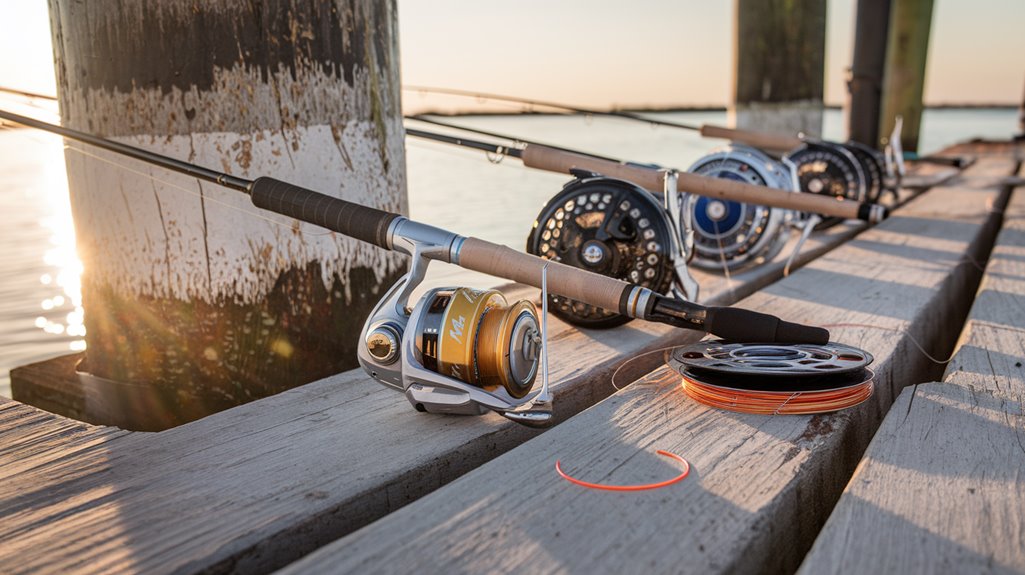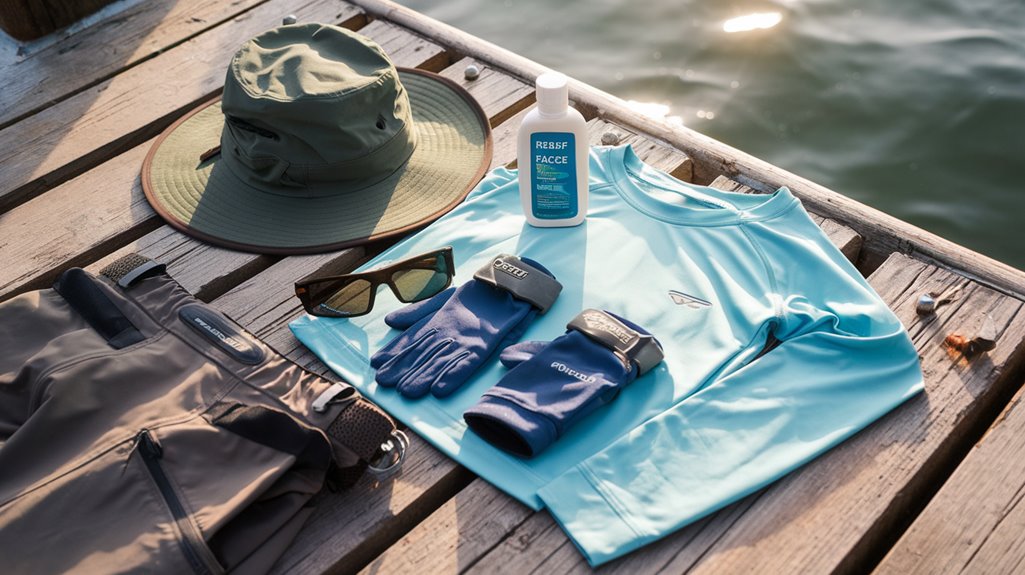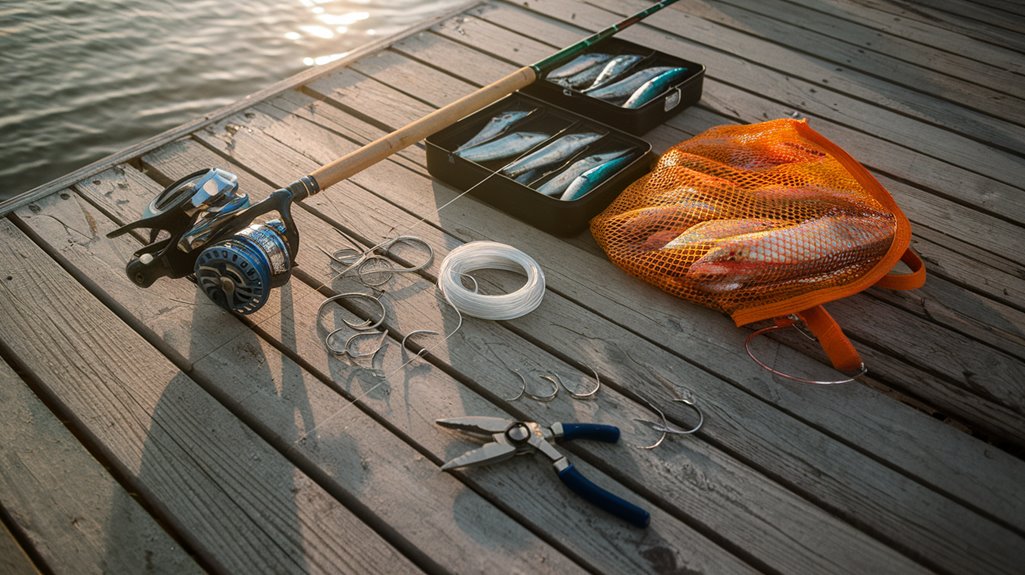You'll need specialized equipment to successfully battle the mighty tarpon, known for their explosive strikes and acrobatic fights. The right combination of rod, reel, and terminal tackle isn't just about landing these silver kings – it's about doing so efficiently while ensuring their survival after release. Whether you're planning to fish the flats or deeper channels, your gear choices will directly impact your success rate and the quality of your fishing experience.
- Key Takeaways
- Essential Rod and Reel Combinations for Targeting Tarpon
- Selecting the Right Line and Leader Materials
- Must-Have Terminal Tackle and Rigging Components
- Live Bait Storage and Handling Equipment
- Protective Gear and Clothing for Extended Fishing Sessions
- Navigation and Fish-Finding Electronics
- Boat Accessories and Anchoring Systems
- Tools for Safe Catch and Release Practices
- Tackle Storage and Organization Solutions
- Weather Protection and Safety Equipment
- Frequently Asked Questions
- Conclusion
Key Takeaways
- Choose a 4000-6500 series spinning reel paired with a 7-10 foot medium-heavy rod for effective tarpon fishing.
- Spool with 50-pound braided line and attach a 60-80 pound fluorocarbon leader approximately 4 feet long.
- Use 5/0 circle hooks and knocker weights for rigging, along with strong swivels for optimal bait presentation.
- Carry essential tools including lip-grippers, dehooking tools, long-nosed pliers, and fish-handling gloves for safe catch-and-release.
- Protect yourself with polarized sunglasses, wide-brimmed hat, high SPF sunblock, and moisture-wicking clothing while fishing.
Essential Rod and Reel Combinations for Targeting Tarpon

A well-matched rod and reel combination serves as the foundation for successful tarpon fishing. For medium-sized tarpon up to 4 feet, you'll want to pair a 4000 series spinning reel with a 7-foot medium heavy rod. When pursuing larger tarpon, step up to a 5500 or 6500 series reel mounted on a 10-foot medium/heavy surf casting rod.
Your reel's drag capacity is vital – a 6000 series with 22-pound drag handles most situations, though dedicated tarpon fishing benefits from an 8000 size reel's additional pressure capability. Spool your reel with 250-300 yards of 50-pound braided line, connecting to a 60-80 pound fluorocarbon leader. This setup provides the perfect balance of strength and control while preventing cutoffs during intense fights. Remember, proper gear matching enhances your casting accuracy and control.
Selecting the Right Line and Leader Materials
Choosing the right line and leader combination proves critical for successfully landing powerful tarpon. You'll want to start with a 20-pound braided line for its excellent sensitivity when targeting smaller tarpon, while upgrading to 50-80 pound braid for larger specimens. For your leader material, opt for either a 30-pound monofilament or 60-80 pound fluorocarbon, with the latter offering superior invisibility in clear water conditions.
When rigging your setup, make sure you're using a leader length of about 4 feet, particularly during sight fishing or when presenting live bait. If you're fishing with circle hooks and dead bait, select heavier leader material to withstand the intense pressure of jumping tarpon and their powerful runs. Always match your line and leader strength to your target size to minimize fight times.
Must-Have Terminal Tackle and Rigging Components

Three essential terminal tackle components form the foundation of a successful tarpon rig: circle hooks, knocker weights, and strong swivels. You'll want to pair your 60-80 pound test fluorocarbon leader with 5/0 circle hooks, especially when using live or dead bait. For ideal rigging, set up a knocker rig with a circle hook when using butterflied mullet.
| Component | Specification |
|---|---|
| Hook Size | 5/0 Circle Hook |
| Leader | 60-80lb Fluorocarbon |
| Leader Length | 4 Feet |
| Reel Size | 4000-6500 Series |
| Rod Power | Medium-Heavy |
Your terminal setup needs to match your medium-heavy rod and 4000 to 6500 series spinning reel for a balanced system. Remember to maintain a 4-foot leader length to prevent spooking these cautious fighters while ensuring enough strength for intense battles.
Live Bait Storage and Handling Equipment
You'll need a properly designed aeration system in your bait well to keep your tarpon bait healthy and active, featuring multiple air stones strategically placed for ideal oxygen distribution. When setting up your bait well, make sure it has rounded corners to prevent bait from becoming trapped and adequate water circulation through a pump system rated for your well's volume. Your bait well's design should incorporate an overflow system that maintains consistent water levels while filtering debris, along with a dedicated pump for periodic water exchanges during extended fishing sessions.
Aeration Systems Setup
When targeting tarpon with live bait, a properly configured aeration system is crucial for maintaining healthy, active baitfish throughout your fishing trip. You'll need to install a high-efficiency aerator that delivers at least 1.0 L/min of air per gallon of tank capacity to maintain ideal oxygen levels between 6-8 mg/L.
Set up your bait tank with an effective water circulation system to eliminate dead spots and guarantee even oxygen distribution. You'll want to monitor water temperature, keeping it between 70-75°F to minimize stress on your baitfish. Install a reliable thermometer for easy monitoring. Don't forget to implement a regular water replacement schedule to prevent harmful ammonia buildup. This thorough aeration setup will keep your mullet and pinfish lively and ready when that trophy tarpon strikes.
Bait Well Design Tips
A well-designed bait well system serves as the cornerstone of successful tarpon fishing with live bait. You'll need to guarantee proper flow-through circulation and maintain ideal water quality to keep your bait fish healthy and active. Install a recirculating pump with aeration capabilities to maximize oxygen levels and survival rates.
Feature | Requirement
—|—
Water Volume | 1 gallon per bait fish
Bottom Surface | Non-slip texture
Water Flow | Continuous circulation
Temperature | Monitored consistently
Salinity | Matched to fishing area
When designing your bait well, focus on creating an environment that mimics natural conditions. You'll want to incorporate adequate space to prevent overcrowding and stress on your bait fish. Remember that proper water temperature and salinity levels are essential – monitoring these parameters regularly will help maintain the health of your mullet and pinfish.
Protective Gear and Clothing for Extended Fishing Sessions

When you're targeting tarpon, your protective gear arsenal must include polarized sunglasses, a hat with a dark underbrim, and a breathable buff to guarantee peak visibility and sun protection during extended sessions. You'll need lightweight, moisture-wicking long-sleeve shirts and specialized fishing gloves to maintain comfort while safeguarding against both sunburn and line burns. Your choice of non-slip, quick-drying footwear with adequate grip becomes essential when you're maneuvering on wet boat surfaces or fighting powerful tarpon from the deck.
Essential Sun Protection Items
Since tarpon fishing often requires long hours under intense sunlight, protecting yourself with the right gear is essential for both comfort and safety. You'll need polarized sunglasses to reduce glare and spot fish more effectively beneath the surface, while a wide-brimmed hat shields your face and neck from harmful rays. Don't forget your UPF-rated long-sleeved shirt for thorough protection while staying cool.
| Item | Primary Benefit |
|---|---|
| Polarized Sunglasses | Reduces glare, enhances visibility |
| Sun Gaiters/Buffs | Versatile neck and face protection |
| Fishing Gloves | Prevents sunburn and line burns |
Complete your sun protection setup with fishing gloves to protect your hands during extended sessions and sun gaiters that you can quickly adjust for additional face coverage when needed.
Moisture-Wicking Clothing Choices
Choosing the right moisture-wicking clothing can make the difference between an enjoyable tarpon fishing experience and a miserable one. You'll want to invest in garments made from polyester or nylon that effectively draw sweat away from your skin during those long hours pursuing tarpon.
Look for shirts and pants with UPF (Ultraviolet Protection Factor) ratings to protect against intense sun exposure. Select items featuring ventilation panels and quick-drying capabilities, which enhance your comfort while maintaining freedom of movement during casting. Base layers and long-sleeve shirts with anti-odor treatments are particularly effective for temperature regulation in hot, humid conditions. When selecting your fishing wardrobe, prioritize pieces that combine moisture-wicking properties with practical features like multiple pockets and reinforced wear points for maximum durability and functionality.
Footwear and Grip Safety
Proper footwear selection stands as a critical safety component for successful tarpon fishing expeditions. You'll need lightweight, waterproof boots or shoes equipped with non-slip soles to maintain secure traction on wet decks and slippery surfaces. Choose footwear that features reinforced toe protection to guard against impacts while traversing rocky terrain.
Pair your protective shoes with quick-drying synthetic socks to manage moisture and prevent uncomfortable chafing during long fishing sessions. The combination of breathable footwear and moisture-wicking socks helps reduce blister formation and maintains ideal comfort throughout your expedition. When selecting your gear, prioritize options that offer both water resistance and ventilation to keep your feet dry from both external splashes and internal perspiration, ensuring you can focus on landing that trophy tarpon.
Navigation and Fish-Finding Electronics
Modern navigation and fish-finding electronics serve as essential tools for successful tarpon fishing. High-quality sonar fish finders equipped with side-scan and down-scan imaging let you locate both tarpon and the underwater structures they frequent. You'll want to invest in a GPS navigation system that helps you chart routes and mark productive spots, especially when exploring unfamiliar waters.
For ideal results, choose a chart plotter that displays real-time tidal movements and current conditions. Many contemporary fish finders integrate with mobile apps, providing vital data about weather patterns and solunar tables. This combination of technologies enables you to build extensive fishing strategies by identifying fish depth, tracking bait schools, and timing your trips during peak tarpon activity periods.
Boat Accessories and Anchoring Systems
The right boat accessories and anchoring systems form the foundation of successful tarpon fishing expeditions. You'll need a reliable anchor system, such as a grapnel or mushroom anchor, combined with an anchor ball for easy retrieval and position adjustments without spooking the fish.
When conditions get challenging, you'll find a drift sock invaluable for controlling your boat's speed in wind or current. This control is essential for precise presentations to tarpon. Mount a quality fish finder to locate promising spots and track water depth changes. Don't overlook the importance of organization – installing rod holders and tackle storage solutions will keep your gear accessible and protected. These additions let you focus on the fight rather than fumbling with equipment when a trophy tarpon strikes.
Tools for Safe Catch and Release Practices
You'll need specialized tools to guarantee safe catch-and-release practices with tarpon, including lip-gripping devices and dehooking tools designed for large gamefish. Your arsenal should include long-nosed pliers, bolt cutters for hook removal, and a quality pair of fish-handling gloves to protect both you and the tarpon during release procedures. These tools, combined with proper heavy tackle and circle hooks, will help you minimize handling time and guarantee the highest survival rate for released tarpon.
Essential Release Equipment Needs
Proper catch and release practices require specialized equipment to protect both anglers and tarpon during the critical moments of landing and release. You'll need a rubberized mesh landing net to safeguard the tarpon's delicate skin and prevent damage during handling. Keep long-nosed pliers and a dehooking tool readily available to quickly remove hooks while minimizing contact with the fish.
Always maintain a bucket of fresh water nearby to revive the fish if needed. When releasing, you'll want to gently move the tarpon back and forth to help oxygenate its gills. To guarantee minimal handling time, have your camera or measuring device ready before landing the fish. This preparation allows you to document your catch efficiently while prioritizing the tarpon's well-being and complying with legal requirements.
Proper Handling Safety Tools
Safe handling tools build upon basic release equipment to protect both angler and tarpon during the catch-and-release process. To minimize stress and guarantee proper handling, you'll need specialized tools designed for these powerful gamefish.
- Start with a rubberized net or boga grip to safely control the tarpon while protecting its sensitive skin from damage
- Use a dehooking tool specifically made for circle hooks, paired with long-handled pliers for quick hook removal
- Keep a fish gripper handy for secure holds during measuring and photography
Always maintain a filled bucket or livewell nearby for revival if needed. These essential tools help you efficiently manage the release process while prioritizing the tarpon's well-being and reducing potential injury to both fish and angler.
Tackle Storage and Organization Solutions
Maintaining an organized tackle system is essential for successful tarpon fishing, where quick access to the right gear can make the difference between landing or losing a trophy fish. You'll want to invest in quality tackle boxes with adjustable compartments to systematically arrange your lures, hooks, and terminal tackle. Waterproof tackle bags provide vital protection against saltwater exposure while keeping your gear accessible.
Implement a clear labeling system for your tackle trays to quickly identify specific gear types during intense fishing moments. A sturdy rod holder or rack isn't just convenient – it's indispensable for protecting your equipment during transport and storage. Choose tackle organizers with dedicated tool holders for your pliers, scissors, and nippers, ensuring these important accessories are always within arm's reach when you need them most.
Weather Protection and Safety Equipment
While tarpon fishing demands skill and patience, it equally requires extensive weather protection and safety equipment to guarantee a successful outing. You'll need to protect yourself from both sun and water elements with essential gear that enhances safety and visibility on the water.
Key protective equipment you must have:
- Polarized sunglasses to cut through water glare and spot tarpon more effectively
- A wide-brimmed hat paired with high SPF sunblock for thorough UV protection
- A waterproof rain jacket that's lightweight and versatile for changing conditions
Don't overlook your personal flotation device – it's not just a legal requirement but a vital safety measure when pursuing these powerful gamefish. These items work together to keep you protected, comfortable, and focused during extended battles with trophy tarpon.
Frequently Asked Questions
What Gear Do You Need for Tarpon?
You'll need a medium-heavy to extra-heavy rod, 5000-8000 series reel with strong drag, 50-pound braided line, 60-80 pound fluorocarbon leader, and circle hooks for live bait or lures.
What Is the Best Fishing Setup for Tarpon?
You'll need an 8000-series spinning reel with 50-80lb braid, matched to a 7-foot medium-heavy rod, plus 60-80lb fluorocarbon leader and circle hooks for ideal tarpon success.
What Is the Best Backing for Tarpon?
You'll want #30-50 test braided backing for tarpon fishing, with 200-300 yards spooled on your reel. It offers superior strength-to-diameter ratio and guarantees you've got enough line for long runs.
What Rod Is Best for Tarpon?
You'll want a 7-foot medium-heavy rod for average tarpon or a 10-foot medium/heavy surf rod for beach fishing. For larger tarpon, choose an extra-heavy rod like the Fenwick HMG Inshore Elite.
Conclusion
You've now got a thorough understanding of the essential gear needed for successful tarpon fishing. With the right rod and reel setup, proper line selection, and necessary protective equipment, you're well-equipped to target these powerful gamefish. Don't overlook the importance of having reliable catch and release tools and safety gear aboard. Proper organization of your tackle will guarantee you're ready when that silver king strikes.

